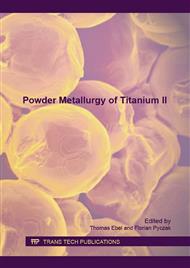p.293
p.302
p.311
p.318
p.325
p.334
p.343
p.351
p.360
Design, Processing and Characterization of Materials with Controlled Radial Porosity for Biomedical and Nuclear Applications
Abstract:
The manufacture of graded materials has gained an enormous interest during the last decade due to the diversity of industrial and biological materials systems that require or are actually designed to implement that criterion; those natural or artificial materials offer multiple possibilities of applications. In this work, a novel uniaxial and sequential compaction device has been successfully designed and fabricated, in order to obtain samples with three different layers; this new device is suitable for both conventional and non-conventional powder metallurgy (PM) techniques. In addition, this device allowed us to use different combinations of powders and space-holder particles, irrespective of their nature, sizes, morphologies and proportions. It has no restriction about applying different compaction pressures for every layer, which may result in increasing or decreasing porosity. This compaction device is especially powerful if the aim is obtaining samples with radial graded porosity for biomedical applications (replacement of cortical bone involved in different joints and dental restorations) and nuclear applications (mimicking burnt used nuclear fuel). Specifically in this work, different samples with radial graded porosity were fabricated and then microstructurally and mechanically characterized: i) Commercially pure titanium (CP Ti) samples, starting from blends CP Ti with 20 vol.%, 40 vol.% and 60 vol.% of Sodium Chloride (NaCl) as space holder, which were placed in core, intermediate and external layers, respectively; processing conditions were 800 MPa of compaction pressure and 1250 °C for 2h in high vacuum of sintering; and ii) CeO2 samples, starting from blends CeO2 with 0.5 vol.%, 3.0 vol.% and 7.5 vol.% of Ethylene Bis Stearamide (EBS) as space holder, which were placed in core, intermediate and external layers, respectively; processing conditions were 460 MPa in external layer and 700 MPa in core and intermediate layers of compaction pressure, and 1700 °C during 4h in static air of sintering. This new device has proved to have unique advantages for solving problems of structural integrity in conventional PM manufacturing in a simple, economic and reproducible way.
Info:
Periodical:
Pages:
325-333
Citation:
Online since:
August 2016
Price:
Сopyright:
© 2016 Trans Tech Publications Ltd. All Rights Reserved
Share:
Citation:


